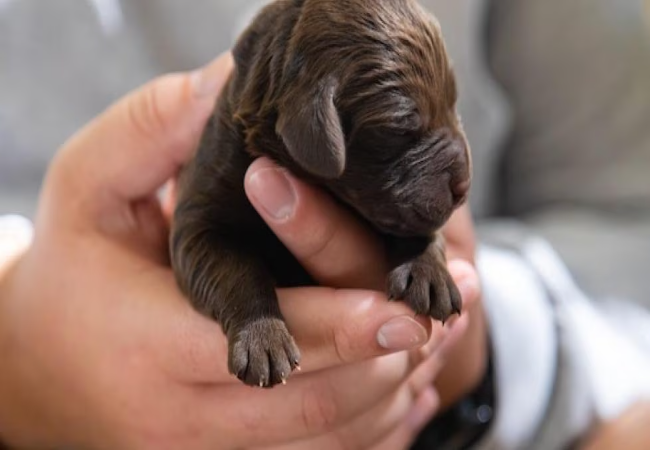Caring for Newborn Puppies 2025: Vet Guide to Health & Best Practices 🐶🍼

In this article
Caring for Newborn Puppies 2025: Vet Guide to Health & Best Practices 🐶🍼
By Dr. Duncan Houston BVSc
Welcoming a litter of newborn puppies is a joyous—but high-responsibility—time. These tiny lives are entirely dependent, fragile, and require close care in the first weeks. As a veterinarian, I’m here to guide you step-by-step: creating the right environment, ensuring proper nursing and nutrition, monitoring growth, supporting immune health, initiating weaning, and safeguarding long-term development.
1. 🛏️ Prepare the Ideal Whelping Environment
- Whelping box size: Big enough to allow the dam to stretch, exit easily, and avoid crushing pups—often 1.5–2× her length; includes low rails to protect puppies (pig rails).
- Ambient warmth: Maintain 85–90 °F (29–32 °C) in the first week; gradually reduce to ~80 °F (26 °C) by week two and ~72 °F (22 °C) by week four.
- Heat source: Use overhead heat lamps—not pads. Leave unheated zones so pups can self-regulate.
- Clean bedding: Start with newspaper and towel layers, switch to absorbent fabric once pups can move—avoid soft fleece that can entangle toes.
- Quiet & private: Reduce human traffic; keep siblings and other pets away to minimize stress and infection—only one trusted handler at first.
2. 🤱 Ensuring Nursing, Colostrum & Feeding Frequency
- Start nursing within hours: Newborns should nurse 8–10 times/day (every 2 hrs) in week one, gradually spacing to 3–4 hours by week two.
- Colostrum importance: The dam's first milk provides critical antibodies for immune protection; essential during the first 24 hrs.
- Orphans & pups missing colostrum: Use commercial colostrum substitutes or maternal serum within 24 hrs—consult your vet immediately.
- Bottle feeding: Pup-specific milk replacer from a puppy bottle, feeding every 2–3 hours if dam is unavailable.
- Monitor nursing efficacy: Ensure no pup is being pushed away; assist weaker ones onto nipples.
3. 🌡️ Temperature & Health Monitoring
- Rectal temp for first-week puppies: 96–98 °F (36–37 °C); recover to 97–100 °F by week two—use small rectal thermometer.
- Weight tracking: Pups should never lose weight; expect daily gains—twice daily in week one, then once daily.
- Fading puppy risk: High mortality (20–30%) often due to hypothermia, infection, congenital defects—watch runts closely.
- Puppy APGAR scoring: Assess color, pulse, reflexes, activity, respiration at 1 and 5 min post-birth; resuscitate if required.
4. 🧼 Hygiene & Infection Control
- Mother’s care: Dam should clean pups and stimulate elimination by licking; mimic this by gently wiping with warm towel until 3–4 weeks.
- Clean environment: Change bedding daily, disinfect whelping box; wash hands and shoes before handling.
- Monitor dam’s health: Watch for mastitis signs—swollen, red, hard teats—feeding problems often stem from dam discomfort.
- Parasite prevention: Limit exposure to other animals and young children until vaccinations start; deworm dam and pups every 2 weeks starting at 2 weeks.
5. 👩⚕️ Veterinary Care & Vaccination Timeline
- Within TWO days post-birth: Vet exam for congenital issues—cleft palate, hernias, overall viability.
- Deworming: Initiate at 2 weeks, then every two weeks until 8 weeks.
- Vaccinations: First DAPP parvo/distemper at ~6 weeks; follow core vaccines per protocol.
- Iron & glucose support: High-risk pups may require supplementation—consult your vet.
6. 🥛 Weaning and Solid Food Transition
- Start weaning: Begin offering moistened, high-quality puppy food at ~3–4 weeks; still allow nursing access as they adjust.
- Weaning timeline: Complete between 5–6 weeks; monitor for dental discomfort as sharp puppy teeth emerge.
- Meal frequency: Offer 3–4 small meals per day as solids increase; maintain hydrating formula/milk as needed.
- Stool observation: Watch for digestive upset and dietary transition tolerance.
7. 🎯 Socialization & Early Handling
- Baby steps: Begin gentle human handling—short sessions for weeks 1–2.
- Sensory development: Eyes open at ~10–16 days; ears by 12–14 days; coordinate walking by week three.
- Critical social window: Introduce new sights and sounds from 3–7 weeks—aim for exposure to at least 100 people by 12 weeks.
- Dam-litter interactions: Maintain intact litter structure until 8 weeks for optimal behavioral learning.
8. 🆘 Recognizing & Responding to Common Emergencies
- Hypothermia warning: Puppies under 96 °F, lethargic, cold to touch—provide immediate warmth and vet attention.
- Failure to thrive: Weaker or non-gaining pups need supplemental feeds or vet evaluation.
- Infections: Signs of diarrhea, vomiting, fever, or unresponsive pups prompt urgent care.
- Bottle-feeding hazards: Avoid aspiration—hold upright and burp gently.
9. 🧩 High-Risk Puppies & Special Support
- Low birth weight/runts: Provide dedicated heat, frequent feeding, and weigh more often.
- Orphaned pups: Require 24/7 feeding, stimulus-assisted elimination, and strict heating.
- Puppies from C-section: Keep dam and pups together post-op when safe—monitor feeding closely.
- Breed-specific caution: Brachi breeds (Bulldogs, Pugs) have thermoregulation issues—more vigilance needed.
10. 🧪 Tools & Services to Support You
- Ask A Vet App: 24/7 advice for feeding schedules, emergencies, or assessments anytime.
- Essential supplies: digital scale, rectal thermometer, heat lamp, absorbent towels, disinfectant, and more.
📌 Final Takeaways for Healthy Start
- Create a safe, warm, and clean environment that mimics maternal care
- Ensure regular nursing and colostrum intake—critical for immunity
- Monitor temperature and weight daily to catch issues early
- Initiate veterinary care promptly after birth
- Gradually introduce solid food and manage weaning smoothly
- Encourage early socialization within safe developmental windows
- Respond quickly to emergencies—proactive measures save lives
- Use expert tools and app support for guidance and confidence






